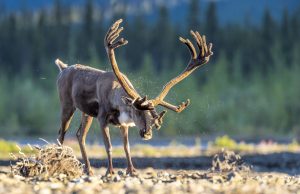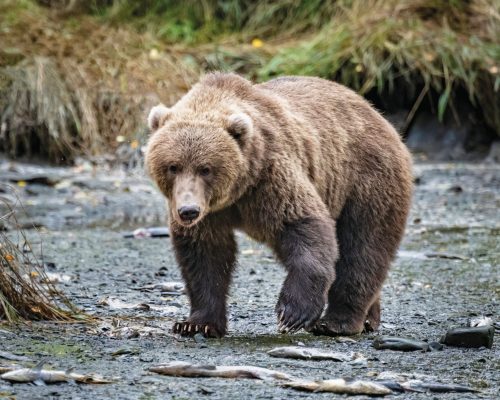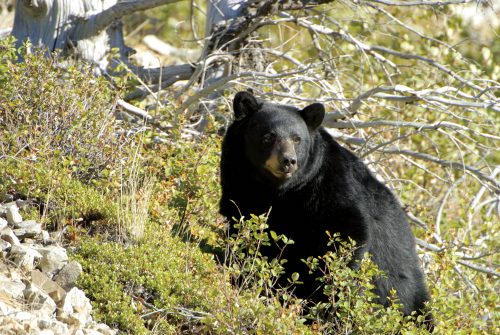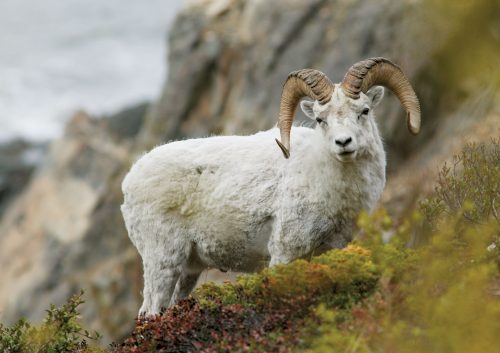
Hunting Alaska’s Biggest Game
I’ve written about preparing for an Alaska hunt before, but it’s been a while, and to tell you the truth, most of it hasn’t changed much. Or maybe it has somewhat.It usually starts with either a text message or a phone call, which reminds me that fall is just around the corner. May, June and July are notorious for these prompts, as hunters start to get the Alaska fever. By summer they’ve usually figured out where they’re going, but really what they want to know is the “what” and “how” information. “I’m coming to Alaska to hunt caribou or moose,” they say. “So what do I need to do and what should I bring?” And lastly, “Will you go with me?” Here’s what I tell them: “Ha-ha. I’d love to but can’t. I’ve got too many irons in the fire as it is. But I can give you the basics and point you in the right direction.”
WHAT TO HUNT? Needless to say, Alaska is a big state with endless hunting opportunities and adventure. It might be climbing a mountain looking for a goat; or maybe pursuing a sheep; or it could be heading south to hunt Alaska’s only deer species. Whatever you pursue, it will be an adventure that you will not soon forget.Like all great hunt memories – the good and the bad – those memories will be determined by what you do to get ready, where you decided to go and ultimately what you planned to hunt. All of these variables are important and sometimes make for expensive decisions, so long before you get on the big jet and head north, you need to make sure you plan accordingly in order to make everything come together. Being knowledgeable – not only about the species you plan to pursue, but all other aspects of the hunt – is the key to success.First things first: What big game does Alaska offer? There are 10 species that a hunter can pursue. With a little luck, all can be taken with success. Let’s first talk about those with antlers.

CARIBOU Caribou are on many want lists, and rightly so. The central barren-ground variety, which is found in Alaska, is very unique. They live on the state’s tundra and migrate with a determination that can only be compared to big game herds in Africa. They also have exceptional antler growth – with no two bulls alike. To see a vast herd roaming the landscape is something truly to behold. Even though most are in decline for various reasons, there are 32 huntable herds in the state. Alaska’s total population is close to 750,000 animals. The Western Arctic Herd, which is the largest in the state, has close to a quarter of a million animals itself.Many people think that all caribou are created equal; this is just not the case. Like elk in the Lower 48, different units will contain bulls that vary greatly in size and trophy quality. For example the Mulchatna Herd, found close to Lake Iliamna, is much smaller compared to the Arctic Herd, but the bulls there are quite a bit bigger in rack and body size.To travel to where caribou live and hunt them is about as adventurous as it gets. Hunting caribou is also relatively cheap compared to other North American big game hunts. Tags are usually easier to get, and in some units you can take more than one. Caribou hunting is enjoyable and best experienced with friends or family. It can at times be tough and easy at others, but the key is to have a plan and stick to it.

MOOSE Like Alaska, moose are big and trophy bulls can be found for the most part throughout the state, especially in the western side of the Last Frontier. Big bulls produce trophy racks as early as 6 to 7 years old, but the monster racks belong to bulls that reach ages of 10 to 12. To take a moose is about as grand an experience as I can think of and also something you will not soon forget. The toughest part of moose hunting comes after the shot. Big bulls weigh close to a ton. Getting one from point A to point B is an experience in itself, but the reward is great. If you plan to hunt them, most willow-choked river valleys throughout the state harbor moose, while in some instances they can be found on the open tundra or among the spruce trees. Moose tags, however, are harder and harder to come by. Most are draw-only now; plus, with the ever-increasing wolf and bear population, the numbers are dwindling.The season runs Sept. 1-20 and a legal bull must be at least 50 inches wide or have three brow tines. Rut occurs around the middle of September and bull moose react to calls and even antler rattling. Calling in a big bull is a life-changing experience!

SITKA BLACKTAIL DEER Pursuing blacktail deer in Alaska is one of hunting’s best-kept secrets. These smaller-framed and stockier cousins of mule deer are numerous and can be found in most of Southeast Alaska. Prince William Sound and Kodiak Island are favorite destinations for deer hunters. When winters are mild, the deer population can and will increase dramatically; the opposite can be said if the winter is severe. Seasons run from August through December, with the rut occurring in November. I’ve hunted each month of the season and found November to be the best time. I’ve also found that hunting the south end of Kodiak will produce the biggest bucks. Blacktails, like whitetails, will respond to decoying and calls, so it might help to bring them along for added success. This hunt will involve a lot of planning and a good set of nerves. Brown bears also like to hunt these unique deer.
ELK Roosevelt elk were transplanted in 1928 to Afognak Island, where they now exist in huntable numbers. They can also be found on Raspberry Island and near Petersburg, in the southeast corner of Alaska. One of three elk species recognized by Boone and Crockett, Roosevelt elk are not as big as their cousins to the south, but to take one is quite an accomplishment. Hunters wanting a chance at an Alaska elk must apply for a tag and then hopefully get drawn. Some areas require successful applicants to have completed a hunter’s education course, so be sure to check before you apply. Elk season in the Last Frontier is from September through October. If you do get drawn, you will need to do quite a bit of research and leg work in setting up your hunt. Hunters also need to be prepared for a tough hunt, as the terrain can be extremely challenging.

BRUINS – BLACK AND BROWN BEARS Of all the big game species in Alaska, I consider bears my favorite to hunt. They’re numerous – population counts show ever-increasing numbers – and can be found throughout the state. Black bears are the most numerous, with a population estimated at 100,000 and they are the most widely hunted bruin, with harvests exceeding 3,000 each year. Black bear hunting does not require a guide and in some units up to three can be harvested. These bears can be found from sea level to high alpine, with the highest concentration in the forested areas of the state. Brown/grizzly bears are classified as the same species; however, the term “brown bear” refers to those animals found in coastal areas, while those found inland are called grizzlies. Kodiak bears are considered a subspecies, as they are genetically and physically isolated and can grow to be monsters.With numbers exceeding 30,000 in the state, brown bears are the only big game species in which nonresident harvest is higher than resident take. Brown bear hunting does require a guide for a nonresident, and for good reason. Brown bears – whether the coastal kind or the inland variety – can be aggressive. If you’re not experienced (most hunters in general have zero experience when it comes to bears), then the best guide you can afford will be worth their weight in gold when it comes to successfully harvesting your bruin.

MUSKOX History tells us that the ancestors of all North American Natives – from Inupiaq Eskimos to Cherokee Indians – crossed the Bering Land Bridge from Russia thousands of years ago. If this is the case, I wonder if the muskox was one of the first animals they encountered? Probably, along with the saber-toothed tiger. A hundred years ago you could not find a wild muskox in Alaska. The population was totally wiped out by man and predators. Since then, muskox have been reintroduced to the state and are doing well. For nonresidents hoping to tag one of these prehistoric creatures, Nunivak and Nelson Islands are your best bet, but tags are hard to come by. Hunters must apply in November for one of these coveted tags.

DALL SHEEP Probably the most popular big game animal Alaska has to offer, especially for nonresidents, is the Dall sheep. Like goats, these “all white” sheep are tough to take and only the toughest, hardiest souls who are up to the challenge should pursue this adventure. If you’re a nonresident, you must have a guide, but tags are pretty liberal and the chance of drawing one is pretty good. Dall sheep are found in the high alpine regions of certain mountain ranges, with the highest population found in Southcentral Alaska.
MOUNTAIN GOAT Considered by many the toughest hunt in the world (I can attest to this), pursuing a goat with a bow or rifle is the ultimate challenge. They can be found in both Southcentral and Southeast Alaska and have also been introduced to Kodiak Island. The season runs relatively long, starting August 1 and running through December in some units, plus spring hunts are available. Even though you can hunt these tough formidable creatures throughout the fall, some hunters prefer to hunt them as late as possible. Early-season goats tend to stay high in the mountains, where feed is best, but as late fall and winter approaches, goats will migrate down to feed at tree line or below. Early-season hunters will have to be in top physical shape and have the stamina and will to get it done. Finding a goat this time of year will require them to reach the high alpine meadows that are very close to the peak of some mountains. Though still tough, winter hunters will need to brave the snowy conditions to reach the tree line for a possible shot. Those nonresident hunters wanting to take on the challenge will need to apply for a tag and also hire a guide who can help you get it done, while resident hunters can get a registration tag and DIY it. This hunt is not for everybody and is something you should consider carefully long before you decide to take the plunge. All aspects should be researched when it comes to this hunt.
BISON Of all the big 10, this is by far the toughest tag to draw, and once you do it, is the toughest to get access to. Alaska is one of the few places in North America where you can still hunt wild free-range bison. Wood bison can be found mostly in the Interior. The herd was introduced several years ago and have flourished due to the incredible conservation efforts of the Alaska Department of Fish and Game. But like I said, getting the tag or drawing it is like winning the lottery!



